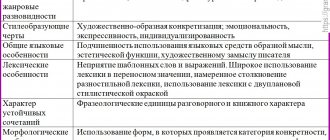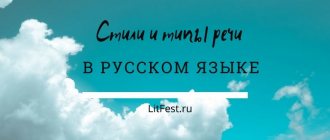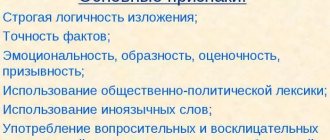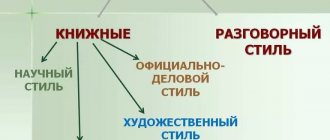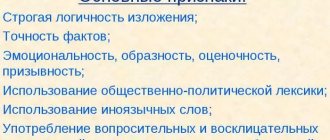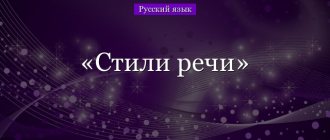Greetings, friends! Pavel Yamb is in touch. Remember when we started talking about speech styles and their features? Each style has its own. The scientific style is considered the most difficult. It wouldn't hurt to learn more about him. So, the scientific style of the text and its features.
Time limit: 0
Navigation (job numbers only)
0 out of 10 tasks completed
Questions:
- 1
- 2
- 3
- 4
- 5
- 6
- 7
- 8
- 9
- 10
Information
This test will show how well you understand text styles.
You have already taken the test before. You can't start it again.
The test is loading...
You must log in or register in order to begin the test.
You must complete the following tests to start this one:
results
Time's up
You scored 0 out of 0 points (0)
Categories
- No category 0%
Your result has been recorded in the leaderboard Loading
- 1
- 2
- 3
- 4
- 5
- 6
- 7
- 8
- 9
- 10
- With answer
- With a viewing mark
- Task 1 of 10
1.
What text style does this passage belong to?
- Yes, he spent the entire scholarship. Instead of buying a new computer, or at least a laptop
- Task 2 of 10
2.
What text style does this passage belong to?
“Varenka, such a sweet, good-natured and sympathetic girl, whose eyes always shone with kindness and warmth, with the calm look of a real demon, walked to the Ugly Harry bar with a Thompson machine gun at the ready, ready to roll these vile, dirty, smelly and slippery types into the asphalt, those who dared to stare at her charms and drool lasciviously. »
- Task 3 of 10
3.
What text style does this passage belong to?
- But I don’t love him, I don’t love him, that’s all! And I will never love you. And what is my fault?
- Task 4 of 10
4.
What text style does this passage belong to?
“Based on the results of the experiment, we can conclude that simplicity is the key to success”
- Task 5 of 10
5.
What text style does this passage belong to?
“The transition to a multi-tier architecture of Internet-oriented client-server applications has confronted developers with the problem of distributing data processing functions between the client and server parts of the application.”
- Task 6 of 10
6.
What text style does this passage belong to?
“Yasha was just a small dirty trickster, who, nevertheless, had very great potential. Even in his pink childhood, he masterfully stole apples from Aunt Nyura, and not even twenty years had passed before, with the same dashing fuse, he switched to banks in twenty-three countries of the world, and managed to peel them so skillfully that neither the police nor There was no way Interpol could catch him red-handed. »
- Task 7 of 10
7.
What text style does this passage belong to?
“Why did you come to our monastery? - he asked.
- What do you care, get out of the way! – the stranger snapped.
“Uuuu...” the monk drawled meaningfully. - Looks like you weren't taught any manners. Okay, I'm just in the mood today, let's teach you a few lessons.
- You got me, monk, hangard! – the uninvited guest hissed.
– My blood is starting to play! – the churchman moaned with delight, “Please try not to disappoint me.”
- Task 8 of 10
8.
What text style does this passage belong to?
“I ask you to grant me a week’s leave to travel abroad for family reasons. I am enclosing a certificate regarding my wife's health. October 8, 2012. »
- Task 9 of 10
9.
What text style does this passage belong to?
“I am a 7th grade student who took the book “Alice in Wonderland” from the school library for a literature lesson. I undertake to return it on January 17th. January 11, 2021"
- Task 10 out of 10
10.
What text style does this passage belong to?
“During the war in the village. Borovoe, 45 houses out of 77 survived. The collective farmers had 4 cows, 3 heifers, 13 sheep, 3 piglets. Most of the gardens on personal plots, as well as an orchard with a total area of 2.7 hectares belonging to the Krasnaya Zarya collective farm, were cut down. The damage caused by the Nazi invaders to the property of the collective farm and collective farmers is estimated at approximately 230,700 rubles.”
maximum of 100 points
| Place | Name | Recorded | Points | Result |
| Table is loading | ||||
| No data | ||||
My other tests
What is it for?
Scientific style is needed to accurately, concisely and clearly express the thoughts of the study. The form of the statement is monologue, the presentation is sequential, the conclusions and phrases are complete.
The scientific style is used in the technical and scientific fields to formalize and express various ideas, achievements, and hypotheses. The research report is designed for people who can evaluate the results.
Main features:
- Compliance with the norms of literary language.
- Lack of personal assessment of events.
- Information content, objectivity.
- Clear text structure.
- Use of special terminology and specific language means.
Oral speech
The scientific style of speech is used not only for writing papers. It is widely used in oral speech. It is used when speaking at conferences, symposiums, and seminars. In this case, the style retains its main features - accuracy, logic, objectivity and abstraction.
In oral speech, several genres are distinguished. When monologuing, a person does not take into account the reaction of another person. Varieties of monologue - report, message, defense of coursework or final qualifying work.
Oral speech can also be presented in the form of dialogue. For example, the scientific community may have a discussion. In this case, a discussion of some controversial topic occurs. It should not be confused with scientific conversation. This type is characterized by a calm discussion of the message being listened to. People can exchange opinions and add information.
There are two more types of oral speech - lectures. Training lectures are held to ensure that students have knowledge in the professional field. There are also popular lectures that are focused on obtaining information. They are carried out sporadically and presented in a simplified form.
There are different speech styles in the Russian language. Each of them performs its own tasks and is used in certain conditions. Scientific is found in dissertations, reports, specialized books and other works. When using this style, it is important to adhere to the above rules.
Varieties and differences
The peculiarity of the scientific style and its difference from others is the division into substyles. Works of the scientific style are more often used in written form, due to the clarity of their design and content. According to the degree of science they distinguish:
- Proper scientific, academic style. It is used in serious works for a narrow circle of specialists, for whom the author expresses his research point of view.
If you know how to write such texts, you can make good money on a text exchange, for example Advego or Etxt.
The academic genre is addressed to professionals. The purpose of the substyle is to identify new data. Used for writing dissertations, abstracts, scientific reports. Examples of works of the academic genre - articles-monographs.
Works of the scientific style are presented in the form of separate works, completed works with a structure appropriate to the genre. Scientific prose includes reviews, lectures, reports, oral presentations at symposia and congresses, scientific reports and dissertations. The works were created by the author for the first time. Therefore they are classified as primary.
Generalization of data, secondary information materials – works created in the form of abstracts or annotations.
- The scientific advertising style is represented by industrial advertising with the benefits and results of purchasing a specific product or using new achievements.
- Scientific reference literature presents information without details, extremely accurate, in a condensed form. The reader receives only the facts.
- Educational and scientific literature is characterized by illustrations and material for repetition. Such works set out the fundamentals of science for schools, institutes, lyceums and other educational institutions.
Publications in a scientific and educational style - for students, that is, future specialists who need to be taught to describe facts. Therefore, the examples given are typical. The principle from general to specific is required.
There is a strict classification, terms are actively used. Examples of the substyle are textbooks, lectures, and reference books. Term papers and reports for seminars are also written in the educational and scientific genre.
- Popular science publications – biographies of outstanding people, stories of discoveries, chronicles of events, essays. It is interesting to read such publications: they contain illustrations, explanations, and examples.
To convey facts and research results to non-specialist readers, a popular science style is used. It is reminiscent of fiction and journalism, since it talks about complex things in an accessible and understandable way.
The readers for whom the popular science genre is intended do not have special knowledge. Therefore, while maintaining the clarity of the scientific style, the presentation is simplified, even emotional language means are used. The purpose of publications is to acquaint readers with the facts described.
Special terms and numerical data are used to a minimum and are explained in detail each time. It is easy to read such texts, there are comparisons with familiar subjects, the presentation is simplified, and specific facts are considered without general reviews.
The substyle is used in popular science publications, books, and children's encyclopedias. It is characterized by greater freedom and is able to change from a newspaper column “This is interesting” to a popular science book close to a textbook.
The presentation is accessible and clear. But according to this criterion, popular scientific and educational scientific texts differ slightly.
A popular science text offers readers the most interesting facts, and the presentation resembles a book style, accessible to non-specialists. Such publications differ from academic ones in that the terms are explained in accessible language, and the results are presented without unnecessary details. Neutral style is similar to popular science.
- The scientific and technical substyle is addressed to specialists in the technical field. Its goal is to apply the achievements of science in practice.
Secondary texts, that is, compiled on the basis of existing sources - abstracts, abstracts, theses, annotations. To reduce the volume of writing, information is condensed during preparation.
Each substyle or genre has its own characteristics, but they do not destroy the unity of the scientific style, maintaining common features.
Steps 2 and 3: chain of arguments
The next two steps are when you first understand the individual episodes of the explanation and, finally, when you understand the entire continuous chain of arguments. These two steps sound similar, but there are significant differences between them.
Step 2 - flashes of understanding : “yeah, this point seems to be clear,” “oh, I’ve already heard this argument,” “yes, the words are familiar, it sounds kind of logical.” The main point here is that the stated statement is harmoniously combined with other facts known to you and does not cause rejection. The new statement does not hang in emptiness, but somehow fits into the system of your knowledge. You feel where this fact can be placed in your head, and perhaps, on occasion, you can mention it appropriately.
However, these flashes of understanding are not connected in a single line. You will not be able to reproduce the general outline of the explanation from beginning to end. When you start doing this, you will immediately have doubts or questions for yourself that you will not answer.
The third stage is when episodic glimpses of understanding are woven into a through thread of narrative that seems clear to you. You feel comfortable in this end-to-end chain of argument. You can walk along it, you can return to the starting point. Maybe you still stumble at some points, but in general you easily glide from a new fact to other facts you know and back. When you listen to a science seminar or read a text, this step feels like a foreshadowing of what comes next. Looking at slides or looking at text, you reason, ask yourself questions and immediately answer some of them.
However, even at this level you feel that your knowledge is incomplete. If you think more deeply about this topic, you may have questions that you cannot answer yourself. Your understanding at this level is technical. You were shown the connection of a new fact with already known ones, you realized this connection and are even able to partially repeat it without looking anywhere. But you cannot answer many questions: “Why this particular method? What if I try not this way, but this way? How does this agree with such a general statement?” In other words, you have learned to slide along the thread of reasoning back and forth, but you cannot break away from it, independently develop and expand the topic.
To “consolidate” this ladder, I want to draw an analogy with the study of foreign words.
- Lack of comprehension is when you see a word in a text but it doesn't resonate with you.
- Stage 1: You looked in the dictionary and learned the meaning of the word, but perhaps within a day you will forget it. The word doesn't fit into your vocabulary.
- Stage 2: you realized the word, saw a familiar root in it, remembered that you heard expressions with it. The word has acquired a special coloring for you. When you meet him again, you will remember him, but you are not yet ready to fully use him.
- Stage 3: you have felt the word, it has entered your active vocabulary, you even feel how it differs from its synonyms. You can explain it and are more or less confident that you are conveying the meaning correctly. However, you may not know, for example, about a whole layer of phraseological units with the “participation” of this word, about its curious etymology and slang meanings.
The main differences between the scientific style and others
I described all other styles in this article.
Publications in a scientific style meet all the requirements of the literary language. They often use standard expressions and phrases, graphic language, formulas, symbols, pictures, drawings, and use notes and references for the accuracy of quotes and verifiability of sources.
Language clichés and cliches are often used: “we are talking about a problem”, “should be about.
A scientific text begins with an introduction to the essence of the problem, justification of the need for research and the novelty of the problem. The subject of research is identified, goals are set for solving problems.
An overview of scientific sources on the subject of research, a basis for work is given, and the theoretical and practical significance of the publication is substantiated. The content of the work, a description of the experiments, the results of the research and conclusions based on their results are given.
History of the style
Scientific language arose due to the fact that various narrow-profile areas of life were rapidly developing. At first it could be compared with an artistic style of speech, but over time it began to differ, acquiring its own characteristic features and characteristics.
In ancient times in Greece, a privileged class of people used a special terminology that ordinary citizens could not perceive correctly. At the same time, experts began to identify the main features of the scientific style of speech. Initially, the terms were used exclusively in Latin, but then all the world's scientists made translations into their native languages.
Over time, the style of the scientific text became precise and concise, which separated it as much as possible from the literary presentation. After all, artistic language introduces significant coloration into the perception of the text, which is unacceptable for the scientific style.
The scientific style of speech and its definition developed rather slowly. The opinions of representatives of science regarding the use of styles were significantly divided. This can be judged by Descartes’ negative statements regarding the works of Galileo. He said that his scientific works contain many artistic means. Kepler was also of this opinion, who believed that Galileo quite often used a literary description of the nature of things.
One of the important stages in the development of the scientific style of speech was the works of Isaac Newton. For a long time they served as a kind of standard of style that everyone tried to adhere to when presenting information.
The scientific style in the Russian state began to take shape only at the beginning of the 18th century. At this historical stage, people writing their own texts or translating began to form their own terminology.
In the second half of the 18th century, the famous scientist Mikhail Lomonosov, together with his followers, gave impetus to the formation of a characteristic scientific type of speech in Russia. Most experts took his works as a basis. The basic scientific terms were finally created only at the end of the 19th century.
Features of vocabulary
- The main distinguishing features of the scientific style are generalization and abstract tone.
- Words are used in specific meanings (word formation, conflict).
- The terms used are familiar words: coil, coupling, tube.
- The main semantic load is on the terms. It is necessary to use special concepts, for example, ethnogenesis, sinusoid.
- They use abbreviations and compound words: GOST, million. The information is accurate, the conclusions are objective, and the character is generalized and abstract.
Features of the presentation:
- Abstract sentences: it seems that...
- Generalized meaning of verbs. They use past and present tense forms to indicate the pattern of the phenomenon: “the author notes...”.
- Most of them are imperfective verbs in stable forms: we will show with examples. Vaguely personal forms with a tinge of necessity predominate: “you need to be able to...”
- To emphasize the description of the process, reflexive verbs and passive participles are used: “explained in detail”, “the definition is given...”
- The use of short adjectives and the pronoun “we” instead of “I” to generalize the text and focus on the detachment of the author’s position: “the attitude is characteristic”, “we have come to conclusions...”
- The structure of sentences and phrases is special: compressed volume, but increased information content.
- Determinative phrases: currency liquidity.
- Definitions are used as terms: “firm sign”, “unconditioned reflex”.
Research level
The higher rungs of this ladder of levels of understanding already relate to research work. On them, a person is able to develop new knowledge himself. However, here too there is a gradation of levels of understanding.
Stage 4 is when you are able to generate understanding on your own. You can go further than you were told, you ask yourself questions and, overcoming technical difficulties, come to the answers. You not only see each step in the chain of arguments, but also understand what will happen if you change it. You can feel the limits of applicability of this chain.
Level 4 is, in general, the routine level of deep but technical immersion in the topic, the level of a good teacher of the subject. You can come up with new learning tasks, but all your ideas will remain within the standard picture and will be based on standard tools. But for fruitful scientific work, you need to rise one step higher - to where you begin to generate ideas, develop theories, and come up with new experimental setups. This doesn’t happen blindly, it doesn’t happen overkill, it’s the result of your accumulated experience in a certain area.
And finally, above all this there is the “epiphany mode” - the ability to make an unexpected leap of understanding that does not in any way follow from uniform research around the issue. Understanding at this level is when you, using either professional intuition or purposefully going beyond the boundaries of your task, suddenly find a non-trivial connection with some other, at first glance, extraneous statement. You formulate a completely new view of things - and numerous consequences immediately follow from it. To do this, a certain “voice” must sound in your head, asking very unexpected questions or offering to try something completely new.
If we return to Richard Feynman's phrase that no one really understands quantum mechanics, it becomes obvious that Feynman was talking about misunderstanding at the very top of the ladder.
Of course, physicists understand the technical aspects of quantum mechanics. But, speaking in the most general terms, physicists do not have a generally accepted understanding of why quantum mechanics should be implemented in our world at all, why our world cannot do without it, why other hypothetical forms of the fundamental laws of the microworld are not implemented.
Therefore, when you come across this Feynman quote as “proof” that quantum mechanics is incomprehensible, contradictory, incomprehensible to a normal person, know that the author giving the quote does not fully understand this statement. He probably does not understand it even at the level of the first step.
Book we recommend:
Igor Ivanov
Syntax Features
The sentences are complex. Homogeneous terms and generalizations are used. Subordinating conjunctions “due to the fact that …”, “due to the fact that …” are widely used. They actively use introductory words “firstly...” and “finally” for a consistent narrative. To combine logically related paragraphs, use combinations of the words “thus” and “in conclusion”.
Almost all sentences are declarative. Interrogatives are very rarely used, only to increase readers’ attention to the question.
There is no character: for the most part, the sentences are impersonal, generalized or vague. Circumstances and action are the main focus. To introduce terms, generalized impersonal constructions are used: “Consider the following example.”
The qualities or properties of a phenomenon are described by adverbs: interesting, convincing, new.
The scientific style cannot be changed. Linguistic norms are defined, and the scientific text “holds” its shape thanks to them.
Manner of presentation of scientific text
Depending on the topic of the material, the terminology and manner of presentation naturally differ. Texts on physics and philosophy cannot be too similar.
But there is always a set of common features that are always present in a scientific text, be it an article, a textbook or a monograph.
As for oral text, for example, a report at a conference, this is:
- Scientific text is always impersonal. It is never written in the first person.
- This is a dry, unemotional, maximally formalized presentation, devoid of figurative language.
- Contains an abundance of terms.
- The use of colloquial language is not permitted.
For written text, all of the above is also true. But beyond this, written texts are characterized by the use of tables, graphs and diagrams.

